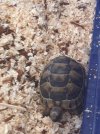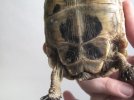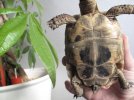D
davidoff
Guest
Hello everyone, i am very happy to have found your forum!
I am very new to tortoises - was given one as a present yesterday. I think it's a greek tortoise, here is a picture:

I put it in a large sandbox, approximately 50cm x 100cm and my local petshop suggested wood chippings as substrate. I also provided it with a shoebox through which i cut a hole for shelter and it has no heating lamp at the moment. (My local petshop does not specialise in tortoises, the one i was given came from out of town).
When it was given to me it was in a very small see-through plastic container and it was extremely active. Ever since I put it in the sandbox it spends most of its time with its head inside its shell (i am assuming it's sleeping.) The only time it was really active was this morning, for approximately 30-40 minutes it moved around the sandbox, and ate a very small amount of the letuce i provided it with.
Is it preparing for hibernation? Do i need to worry about its behaviour? Is it normal for them to sleep for so many hours?
I should also note that i live on a small island in the mediterranean, with moderate climate. Average temperature this time of year is approx 17 Celsius in the day time and 8 Celsius in the night time.
I would be very happy to hear comments or suggestions on this issue. Very pleased to meet you all!
I am very new to tortoises - was given one as a present yesterday. I think it's a greek tortoise, here is a picture:

I put it in a large sandbox, approximately 50cm x 100cm and my local petshop suggested wood chippings as substrate. I also provided it with a shoebox through which i cut a hole for shelter and it has no heating lamp at the moment. (My local petshop does not specialise in tortoises, the one i was given came from out of town).
When it was given to me it was in a very small see-through plastic container and it was extremely active. Ever since I put it in the sandbox it spends most of its time with its head inside its shell (i am assuming it's sleeping.) The only time it was really active was this morning, for approximately 30-40 minutes it moved around the sandbox, and ate a very small amount of the letuce i provided it with.
Is it preparing for hibernation? Do i need to worry about its behaviour? Is it normal for them to sleep for so many hours?
I should also note that i live on a small island in the mediterranean, with moderate climate. Average temperature this time of year is approx 17 Celsius in the day time and 8 Celsius in the night time.
I would be very happy to hear comments or suggestions on this issue. Very pleased to meet you all!
Last edited by a moderator:

